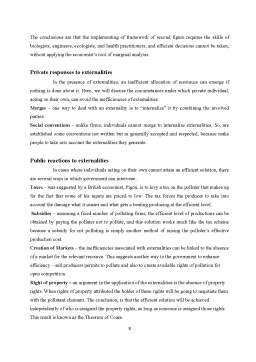Extras din proiect
Public finance focus on the way in which government affects the allocation of resources and the distribution of income and on the use of taxing, spending, and monetary policies to affect the overall level of unemployment and the price level.
Public finance economists analyze not only the effects of actual government taxing and spending activities but also what these activities ought to be. Views of how government should function in the economic sphere are influenced by general attitudes concerning the relationship between the individual and the state. Political philosophers have distinguished two major approaches.
In an organic view, society is conceived of as a natural organism. Each individual is a part of this organism, and has significance only as part of the community, and the good of the individual is defined with respect to the good of the hole. Individuals are valuable only in their contribution to the realisation of social goals. These goals are determined by the government.
In a mechanistic view of the society, government is a contrivance erected to further individual goals. There is considerable disagreement over how the government should promote sometimes conflicting individual goals.
Government can intervene in market flaws like negative externalities, epidemics, accidents, pollution and redistribution like general poverty.
The government has a lot of opportunities to intervene in economy like burden or subsidize the sale or the private purchase with taxes and subsidies, to restrict or to allow for private sale or purchase, to public provision by health, education, energy, transports and public financing of private provision.
The governments cannot be seen as the ones who act to mitigate the market flaws or to influence the resources’ distribution. Governments must interpret the preferences of many citizens.
The virtues of the market economy are:
- the intuitive approach – the market system allows the coordination without the need to understand how the system works as a whole, auto-correction of imbalances, decentralized power, relative prices reflect relative costs, stimulus to the innovation and to the growth;
- the formal approach which suppose perfect competition: many enterprises, product homogenous, entry/exit easy, profit = 0
THE THEOREM OF WELFARE ECONOMY
The theorem of welfare economy is used to distinguish the circumstances under which can be expected to perform well from those under which markets fail to produce desirable results.
Let’s imagine an economy with two people a and b who consume two commodities with fixed supplies. Each person has a set of conventionally shaped indifference curves that represent their preferences for the products. An analytical device known as the Edgeworth Box depicts the distribution of the products between persons.
An allocation at which the only way to make one person better off is to make another person worse off, is called Pareto efficient. Pareto efficiency is used as the standard for evaluating the desirability of an allocation of resources. The preference of person b is given by the curve b0. Person b is indifferent between any points along this curve. Point g and h are possible but is not Pareto efficient. It is possible to person a to improve his welfare without person b being damaged.
The absolute value of the slope of the indifference curve indicates the rate at which the person is willing to trade one good for an additional amount of another, called the marginal rate of substitution. Pareto efficiency requires that marginal rates of substitution be equal for all consumers: MRSa=MRSb.
The production possibility curve shows the maximum quantity of a product that can be produced along with any given quantity of another product. The marginal rate of transformation shows the rate at which the economy can transform a product into another. The concept correspond the concept of utility possibility curve that shows the maximum amount of one person’s utility given the other individual’s utility level. All points on or below the utility possibility curve are attainable by society; all points above it are not attainable. By definition all points on the utility possibility curve are Pareto efficient, but they represent very different distributions of real income between persons. The best point is given by a social welfare function and it is some function of each individual’s utility: W= F(Ua ,Ub).
CHAPTER II. Objectives and Instruments of Governmental Intervention
The state intervenes in the economy when the market does not produce the expressed result. In this case we say that the market fails. The argument in favour of intervention is based on flows’ identification.
Preview document
Conținut arhivă zip
- Economy of Market and Public Intervention - Objectives and Instruments of Governmental Intervention.doc












